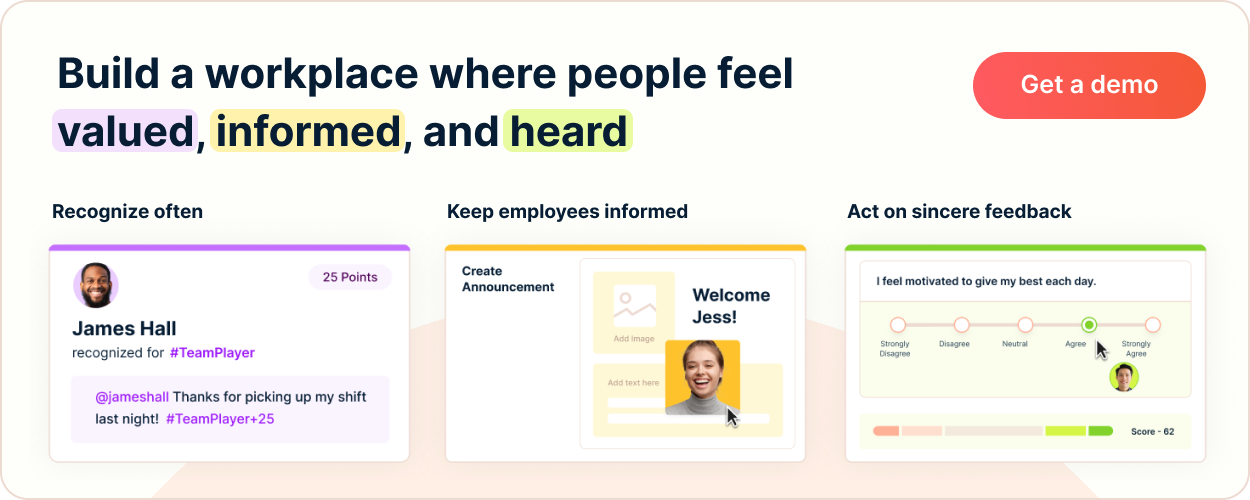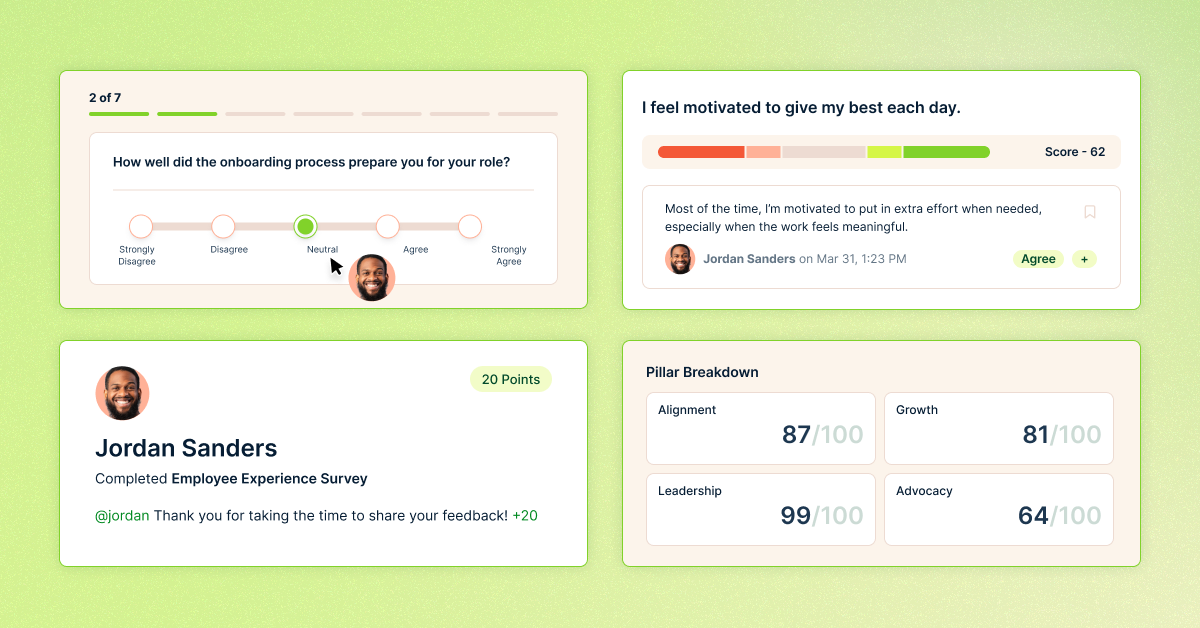How Peer-to-Peer Recognition Improves Company Culture: Tools & Tips That Work

Here's the TL;DR
Peer-to-peer recognition is a powerful driver of company culture, going beyond top-down praise to create authentic, meaningful appreciation between colleagues. When employees recognize each other, it boosts engagement, retention, and trust—building a workplace where contributions feel valued. Research shows recognition can increase productivity by up to 14% and reduce turnover by 31%.
For startups and small businesses, peer recognition is especially impactful. It distributes feedback across teams, supports inclusion, and encourages shared values without the need for heavy HR systems. Recognition can take many forms—Slack shout-outs, public kudos walls, digital badges, or reward points—and works best when it’s timely, transparent, and consistent.
The best recognition platforms share key features: ease of use, real-time feedback, customizable rewards, integrations with everyday tools, and analytics to track engagement. Top options include Nectar (flexible, budget-friendly, highly rated), Bonusly (point-based rewards), Motivosity (focuses on connection and feedback), and Assembly (simple, affordable for startups).
To succeed, rollout requires leadership participation, cultural campaigns, onboarding, challenges, public celebration, and ongoing feedback. Ultimately, peer-to-peer recognition transforms everyday praise into a cultural strategy—strengthening inclusion, gratitude, and emotional connection while scaling engagement through tools like Nectar.
Building a strong company culture isn’t just about mission statements or ping-pong tables. It starts with people.
More specifically, it starts with how people treat and recognize each other at work. That’s where peer-to-peer recognition makes a real difference.
Workplaces that prioritize recognition experience better employee engagement, higher retention, and a more positive environment. But recognition doesn’t have to come from leadership alone. Some of the most meaningful praise comes directly from colleagues.
How does peer-to-peer recognition support workplace culture, and what are the top employee recognition tools? We’ve got the answers… and the tips you need to make it all work.
What Is Peer-to-Peer Recognition?
Peer-to-peer recognition is when employees acknowledge and appreciate each other’s contributions. It happens outside of formal reviews. It’s spontaneous, authentic, and often more powerful than top-down praise.
What are some examples of peer-to-peer recognition?
- A team member thanking a colleague in Slack after a tough deadline
- Shout-outs during team meetings
- Digital badges or points awarded through an employee recognition software
The key? The positive feedback comes from equals.
How Recognition Affects Company Culture
Culture lives in the everyday. Small moments shape how employees feel at work. Consistent recognition encourages people to look for the good in others, which in turn influences everything from trust to engagement.
How does recognition affect company culture?
- When peers notice each other, they build mutual respect, which creates trust and psychological safety,
- Inclusion means everyone can give and receive recognition, not just managers.
- Teams that feel appreciated stick together, boosting retention.
- Employees who feel seen are more likely to be engaged and go the extra mile.
Gartner reports that recognition can boost productivity by as much as 14%. Meanwhile, SHRM notes that organizations with strategic recognition programs report 31% lower voluntary turnover.
The Business Case for Peer Recognition
For small businesses and startups, budgets are tight and teams wear many hats. Peer-to-peer programs give you high impact without needing a large HR department or costly performance management systems.
How can startups and small businesses benefit from peer recognition?
- It distributes recognition across the organization
- It encourages a feedback-rich culture
- It reduces dependence on quarterly or annual review cycles
Companies using the best software for employee recognition often report higher engagement and team morale. These programs become more than tools—they’re part of the way work gets done.
6 Ways Peer Recognition Builds a Positive Workplace
What are the direct cultural advantages of peer recognition in the workplace? It builds a positive professional environment in a variety of ways.
1. Encourages Inclusion
Recognition allows every voice to matter. When everyone can give praise, even new or junior team members feel empowered.
2. Supports Shared Values
Recognition platforms can align with core values. For example, users may tag praise with labels like "Innovation" or "Teamwork."
3. Increases Engagement
Employees who receive recognition consistently are more likely to stay invested in their work. It creates a feedback loop of effort and reward.
4. Creates Transparency
Public recognition walls or feeds showcase effort and success across departments. It’s a great way to boost morale.
5. Builds Gratitude Habits
Giving recognition trains employees to notice and appreciate the good. That gratitude spreads throughout the workplace.
6. Boosts Emotional Connection
Recognition fosters connection. Colleagues who support each other build stronger relationships, even across remote teams.
What to Look for in Peer Recognition Tools
It should be no surprise that every platform is different. The top employee recognition tools share a few essential features that directly support culture.
Key Features to Look for in Peer-to-Peer Recognition Software
Ease of Use
User-friendly interfaces matter. If a tool feels complicated or clunky, adoption will suffer. Look for platforms that integrate with tools like Slack or Microsoft Teams.
Customizable Rewards
Choose software that supports both monetary and non-monetary rewards. The best employee recognition software for small businesses includes gift cards, company swag, and custom awards.
Real-Time Feedback
Timely recognition is more impactful. Top-rated employee recognition software lets users recognize peers instantly—right after the good work happens.
Integrations
The best peer to peer recognition software connects with your workflow. Integrations with HRIS platforms, calendars, and communication tools make usage seamless.
Analytics and Reporting
Insight matters. You want to see what values are being celebrated, how often teams are engaging, and who your culture champions are. This helps HR refine initiatives and drive stronger outcomes.
Top Peer-to-Peer Recognition Platforms
Some of the best employee appreciation tools make peer-to-peer recognition work at scale. Each platform supports culture-building in its own way.
Nectar
Nectar stands out as one of the most recommended peer-to-peer recognition platforms. It offers a sleek user interface, seamless integrations with major platforms, customizable awards, and detailed analytics.
It’s the best business software with peer-to-peer recognition for companies looking to boost engagement while staying within budget. Small businesses and startups love Nectar’s flexibility. It’s top-rated business software for employee awards and highly scalable for growing teams.
Bonusly
Bonusly is another leading business software platform for peer to peer recognition. It offers point-based rewards and custom achievements. The platform is widely used in mid-sized organizations.
Motivosity
Motivosity focuses on culture and connection. The platform promotes recognition alongside employee feedback and surveys, creating a broader engagement suite.
Assembly
Assembly offers a user-friendly recognition feed and integrates with several communication tools. It has low-cost pricing plans that are perfect for startups seeking simple peer feedback.
Top Peer-to-Peer Recognition Platforms
Tips for a Successful Rollout of Peer Recognition Software
Peer-to-peer recognition tools don’t work unless people actually use them. Fortunately, you can create momentum when launching a peer recognition program. Just follow six simple steps.
1. Start With Leadership
When managers and executives use the platform, employees follow.
2. Create a Recognition Culture Campaign
Use your employee newsletter to promote it. Share success stories.
3. Train and Onboard
Offer short videos or walkthroughs on how to give recognition.
4. Set Challenges
For the first month, encourage a goal (e.g., "Give three shout-outs per week").
5. Celebrate Publically
Share a "Recognition Roundup" monthly in team meetings.
6. Gather Feedback
Ask employees what they like and what they want improved.
7. Implement Consistent Improvement
Based on the feedback you collect, make adjustments to the campaign to encourage even more engagement and success.
How Nectar Helps Culture-Driven Teams Thrive
Nectar makes recognition easy and meaningful. It checks every box for culture-building:
- Real-time, peer-to-peer recognition from any device
- Reward points for employees to redeem their choice of more than 200 gift cards
- Custom awards that reflect your company values
- Integration with Slack, Teams, and HR platforms
- Insightful analytics that track engagement
Whether you're wondering what's the best employee recognition platform, or which employee recognition software is best for startups, Nectar ranks among the top software for peer-to-peer recognition in both categories. It’s designed to be simple, scalable, and human-centered.
Why Peer-to-Peer Recognition Software Strengthens Company Culture
Peer-to-peer recognition is more than a perk—it’s a cultural strategy. It encourages inclusion, builds trust, and makes everyday contributions feel seen. The right platform can turn those small gestures into long-term impact.
When companies invest in top-rated employee recognition software, they create a workplace where people feel appreciated, connected, and empowered.
Ready to build a stronger workplace culture? Try Nectar’s peer-to-peer recognition platform today—built to connect teams, reward effort, and spark engagement that lasts.














